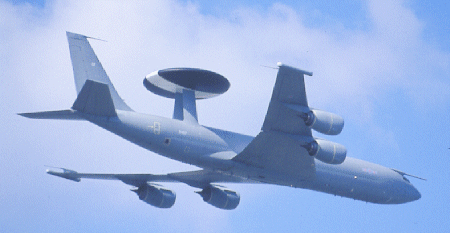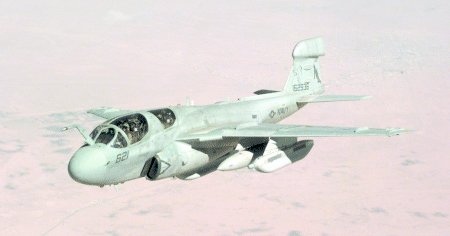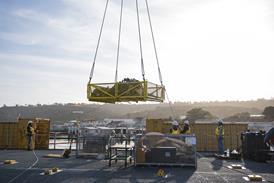Stewart Penney/RAF Brize Norton & RAF Waddington DeeDee Doke/Aviano AB & RAF Mildenhall

Missions over Iraqi and Yugoslavia would not be possible without force multipliers such as the Airborne Warning and Control System (AWACS), electronic warfare (EW) assets and tankers. The UK Royal Air Force's Boeing E-3D Sentry AEW1s have operated over the former Yugoslavia with similar aircraft from the US and French air forces and the multinational NATO AEW Force.
The success of the AWACS during the Allied Force operation over Kosovo is clear; there were no mid-air collisions and no blue-on-blue incidents, where friendly forces were attacked. Without tankers, fighters would be restricted to striking targets around the edges of hostile countries. Without EW protection, losses would be significant and politically unacceptable.
For the RAF's Sentrys, lessons from Kosovo mirrored experience from recent large exercises which found that more mission consoles and radios are required. The focus of the Sentry's mission for the RAF has shifted from defensive AEW to offensive AWACS, says Sqn Ldr Jeff Portlock, flight commander plans, 23 Sqn.
Gp Capt Ron Cook, Station Commander Waddington, says planning is under way to give the Sentrys five more operator consoles and additional radios. The advantage of nine consoles is the speed of information flow around the operators, but experience has shown that there is a risk of reaching workload saturation. Portlock says: "We could do better with more seats." His equivalent on 8 Sqn Ldr Archie McCallum adds: "The aircraft is a distribution system. We fuse data and distribute it. Without bodies on the aircraft and the radios, we're not doing our best."
More radios are needed because so many aircraft need to link with the AWACS. As one operator says: "Everybody wants to talk to the AWACS." The JTIDS tactical datalink proved invaluable during Allied Force. Portlock predicts that, like precision-guided munition capabilities today, in the next 20 years, possession of JTIDS will become a prerequisite for joining a coalition force.
Kosovo air campaign commander Lt Gen Mike Short believes jamming platforms such as the Northrop Grumman EA-6B Prowler (below) are vital. "We use a lot of them and we placed a lot of stress on the system. There are only X number of those platforms."

Archetypal force multiplier
Sqn Ldr Tim Walker, flight commander operations, 101 Sqn, says recent operations justify the need for tankers and show that the replacement of BAC VC10s is necessary - a process under way with the RAF's Future Strategic Tanker Aircraft (FSTA) competition.
Kosovo "reinforced how vital air-to-air refuelling is-tanking was the archetypal force multiplier", says Officer Commanding 216 Sqn, Wg Cdr Dave Williams. Tankers allowed the air commander to keep aircraft on station longer, and when extra strike aircraft were deployed, tankers allowed an increase in tempo.
The RAF's Williams says the value of large tankers like 216 Sqn's Lockheed TriStars was underlined. "We were always there for the fighters to rotate through, which isn't necessarily true for the smaller aircraft which have to shuttle back to base. The receivers can't always wait." He says RAF doctrine has been to "get as many hoses into the sky as possible, but with our single hose the most important thing was not refuelling multiples, but to be there a long time".
Sqn Ldr Gordon Pell, 101 Sqn's flight commander for training, is hopeful that equipment such as JTIDS will be integrated into the FSTA from the start. Walker says a good colour radar with a large display is crucial to allow station keeping at beyond visual range at night, which will reduce crew workload and lower risk.
Pell and Walker agree that the FSTA should have three crew and three hoses - two underwing and one under fuselage - and they want a powered floor to ease main deck cargo handling. The VC10 K2/3s have fuel tanks in the main cabin, but the FSTA is expected to be an Airbus A300/A310 or Boeing 767, with all fuel beneath the main deck. Walker, who served as a McDonnell Douglas KC-10 Extender exchange pilot with the US Air Force, says the RAF will then be able to follow the US lead. "To take 12 [Panavia] Tornado GR1s to Red Flag [exercise] a VC10 moves the aircraft, a TriStar the personnel and a [Lockheed Martin] Hercules the spares. The USAF uses two KC-10s."
Replacement of the TriStars is less pressing. Williams says as the aircraft is extremely capable and "it is difficult to predict anything beyond the TriStar". If the FSTA is "something close to the size, range and capability [of the TriStar], it can't be far wrong".
Stuart Mitchell, the 216 Sqn flight commander training, says payload/range is critical. The TriStar's ability to take 32t of freight to Kuwait in one hop is vital, he says, adding that staging via another air base adds delays.
Whichever airframe becomes the FSTA is operated commercially with a two-crew flightdeck, but RAF personnel believe the workload in the tactical environment makes a three-crew cockpit crucial. Walker says the refuelling specialist, now the flight engineer, should be kept as it adds another pair of hands and eyes. Mitchell agrees. "When things get busy or go wrong there is a tremendous workload on a two-man crew which also has to manage the tactical picture," he says. He admits scepticism at a two-man tactical crew and is "looking with interest" at the C-130J Hercules which has a two-crew flightdeck. The third person need not necessarily be a flight engineer but perhaps a loadmaster with extra training or a third pilot.
A consideration for the FSTA is leasing the tankers under a public finance initiative and using civilian crews. Walker is concerned that this may limit the tanker force's effectiveness. "We're in a good position, on a high. We're a good force, used a lot and we've got to make sure that keeps going." He adds: "We have to be careful about privatisation as it may not be possible to increase utilisation." He says military pilots are expected to deploy overseas at "the drop of a hat": he is concerned that civilian pilots will not be in a position to match that readiness.
The Boeing KC-135 Stratotanker is the mainstay of the USAF's tanker corps and Col Glenn Spears, commander of the 100th Air Refueling Wing at RAF Mildenhall, predicts that the KC-135 airframe will be serviceable for years to come as it "is still a very young airframe. It has a low amount of flight hours. The whole fleet has been re-engined." He concedes, however, that an upgrade under way throughout the USAF of the aircraft's avionics is going to "provide a quantum leap in reliability and maintenance-as well as operations."
Timely, accurate intelligence has once again been proved crucial by the Allied Force and Desert Fox operations. The capabilities of future missiles such as the long-range stand-off Matra BAe Dynamics Storm Shadow and the anti-tank Alenia Marconi Systems Brimstone, both due to enter service shortly, make intelligence even more important, says the officer commanding II (AC) Sqn, RAF.
Commander of the Royal Netherlands Air Force (RNLAF), Lt Gen Ben Droste, says: "A big lesson of war is the need for near real-time intelligence gathering, the fusion of information and its transmission back to the cockpit." Timescales need to be short as "targets are on the move all the time: we are talking minutes, not hours." Wet film systems are "too slow", so the RNLAF will procure an electro-optical system with a datalink download capability.
Information fusion
Timely intelligence is "absolutely key" agrees RAF chief of the air staff Sir Richard Johns, but he cautions that too much data can deluge the system and slow the transfer of the information to where it is needed. Intelligence must be 100% reliable so that it can be passed rapidly to the targeting and attack systems.
The commander of the Kosovo air action, USAF Lt Gen Michael Short, says that while the fusion of intelligence, surveillance and reconnaissance information has made giant strides, "we still have a way to go".
The RAF's tactical reconnaissance capability is good, says Johns. At a strategic level and for operational planning, there is "an area of weakness". The Airborne Stand-Off Radar (ASTOR) will enter service in the next decade, however, and "will not only highlight targets for the RAF, but will provide a vital picture to ground commanders and aid their naval counterparts".
Storm Shadow will "make things much more complicated in terms of intelligence. If you fire them from a distance, you have to be aware of where the target is," says the OCII commander. "It is the same for Brimstone - can it tell blue-on-blue or an armoured personnel carrier from a tractor?" Allied Force proved yet again that "you can't get enough reconnaissance".
Source: Flight International























